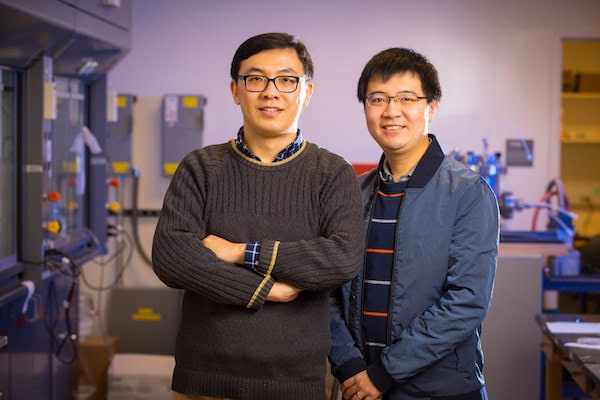
[Image above] Qiaoqiang Gan, left, and Nan Zhang. Credit: Douglas Levere; University at Buffalo
Running out of juice on our mobile devices is a big frustration in today’s world. And it always seems to happen at the most inopportune times: When you’re shooting video of your baby’s first steps or using GPS in an unfamiliar area. Or when you’re out for a run and forgot to charge your fitness tracker.
And unless you remember to bring a back-up battery charger or are able to locate an electrical outlet in close proximity, you’re pretty much out of luck.
But what if you didn’t have to worry about remembering to charge your device or bringing along a charger? What if you could move one of your body parts to generate that much-needed charge on your device?
Researchers at the University at Buffalo along with the Institute of Semiconductors at Chinese Academy of Science (CAS) have developed a triboelectric nanogenerator that can deliver up to 124 volts of power to light 48 red LED lights, according to a news release from the University at Buffalo.
Led by Qiaoqiang Gan, associate professor of electrical engineering in the School of Engineering and Applied Sciences, the researchers created a small metal tab that can generate electricity from simple movements when placed on the body.
“No one likes being tethered to a power outlet or lugging around a portable charger,” Gan, who is also lead author of the paper, says in the release. “The human body is an abundant source of energy. We thought: ‘Why not harness it to produce our own power?’”
The tab, made of a layer of polydimethylsiloxane (PDMS) between two thin layers of gold, harnesses the power of the triboelectric effect, which leads to static electricity. The tab is attached to the body, and, when one of the gold layers is stretched and crumpled, the body’s movement creates friction between the gold and PDMS—causing electron movement between the gold layers.
“The more friction, the greater the amount of power is produced,” Yun Xu, professor of the Institute of Semiconductors at CAS, explains.

A prototype of the triboelectric nanogenerator. Credit: University at Buffalo
And fingers are not the only power generators. Any moving body part is a candidate for power generation, Gan explains in an email. “Any part of the body where there is bending or moving—our knees and elbows are good examples—that is capable of creating friction can be harnessed into power.”
The researchers plan to enlarge their sample sizes of gold in future studies to increase how much electricity is generated. They also are working on a portable battery that can store energy from their nanogenerator.
As the Internet of Things continues to evolve, the scientists say their research could improve wearable devices.
“The nanogenerator we’re developing could change how we charge common devices such as smartphones and tablets, especially when people are travelling or without easy access to power outlets,” Gan proposes. “But it also has great potential for wearable technology. For example, wearables that monitor our health need reliable sources of power that aren’t bulky. This advancement could be very useful in that domain.
“More broadly, any mechanical movement energy, like wave energy in the river/ocean and wind energy, can also be harvested by this type of device if we can scale it up,” he adds. “In particular, mechanical energy at the tires of vehicles and sport machines are our next target.”
The paper, published in Nano Energy, is “Wearable and robust triboelectric nanogenerator based on crumpled gold films” (DOI: 10.1016/j.nanoen.2018.01.032).
Did you find this article interesting? Subscribe to the Ceramic Tech Today newsletter to continue to read more articles about the latest news in the ceramic and glass industry! Visit this link to get started.
Author
Faye Oney
CTT Categories
- Electronics
- Energy
- Material Innovations
- Nanomaterials
- Weekly Column: “Other materials”
Related Posts
Other materials stories that may be of interest for December 17, 2025
December 17, 2025
Other materials stories that may be of interest for December 10, 2025
December 10, 2025

